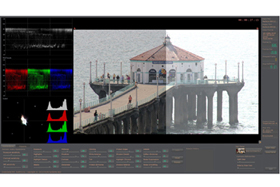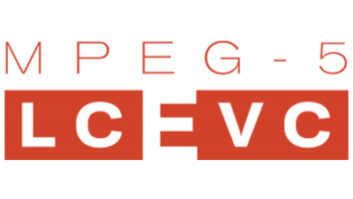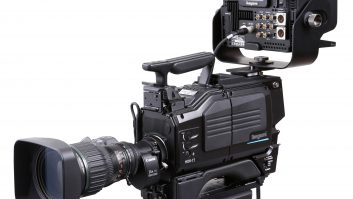
A Danish technology start-up is introducing an image processing system that it claims “significantly enhances” live TV pictures, including Ultra HD. The LiveScene product from Pion addresses what it says are the image quality limitations such as lack of highlight and shadow detail, noise and poor contrast of live television broadcasts.
“We are optimising the dynamic range by bringing down the highlights and extracting detail from the shadows,” explained Kenneth Tang Laerke, Pion’s CEO. The picture of the LiveScene user interface side-by-side screen shows an image after (left) and before the process.
“For example, when a stadium during a football match is half drenched in sunlight and half in shade it is extremely hard to pull out highlights with current technology. We’re able to bring that into a quality, using sophisticated image processing, that is quite frankly unseen before.”
Aimed at outside broadcast and studio production environments, the LiveScene product takes the live uncompressed feed from broadcast cameras, or an inbound compressed stream from live ENG or event coverage, and enhances it in real time to overcome common live production challenges caused by adverse conditions.
The single rack unit, plus control panel, fits into an existing OB or studio-based infrastructure, and is said to “drastically enhance” the work and profile of the camera control unit (CCU) operator or studio technician.
Although claimed to be a real time process, Tang Laerke admits to a fixed latency of two frames.
“In traditional High Dynamic Range (HDR) imaging you have to shoot multiple exposures or use more than one camera,” he said. “Pion is similar technology-wise to HDR, but we are able to do it with one camera or a number of cameras. We have no special requirements in terms of what camera you are using, so we could achieve better image quality from even fairly low-end cameras.”
Although Pion wouldn’t disclose names, it said it was testing the technology with OB companies and broadcasters. It also said the UK was its main focus given the attractiveness of the UK’s OB market.
Richard Yeowart, MD of Arena Digital who has not seen the product observed: “The pictures always look great in the OB truck – most of the loss/compression is down to the onwards signal transmission. You end up with a fraction of the data at home that we start with, good compression and codecs are the key.”
Tang Laerke asserted that lack of detail in highlights and shadows is a major issue for broadcasters. “One of the things consumers most appreciate is improved dynamic range, over resolution and over smoothness and framerate,” he said.
“This becomes even more of an issue as the resolution gets higher. Viewers move closer to the screen and the pixel count rises so you see more of these issues.”
Michael Jonsson, Pion CTO, added: “With the advent of Ultra HD acquisition, which further accentuates common picture quality issues, we believe our Live Camera Enhancement is perfectly placed to address the quality issues that capturing and processing live 4K and beyond will bring to a production.”
Planned future enhancements including a product tuned to improve colour correction.
“Commodity technology is the enabler for us,” said Tang Laerke. “We are using off the shelf GPU technology that only recently became powerful enough to process 30 frames a second at 1080p, or 60 interlaced in real time.”
Tang Laerke and Jonsson founded Pion this year, backed by Danish venture fund Seed Capital. The entrepreneurs previously formed Danish digital imaging photo software company Pixmantec – acquired by Adobe Systems in 2006 – and created the RawShooter software application.
By Adrian Pennington







